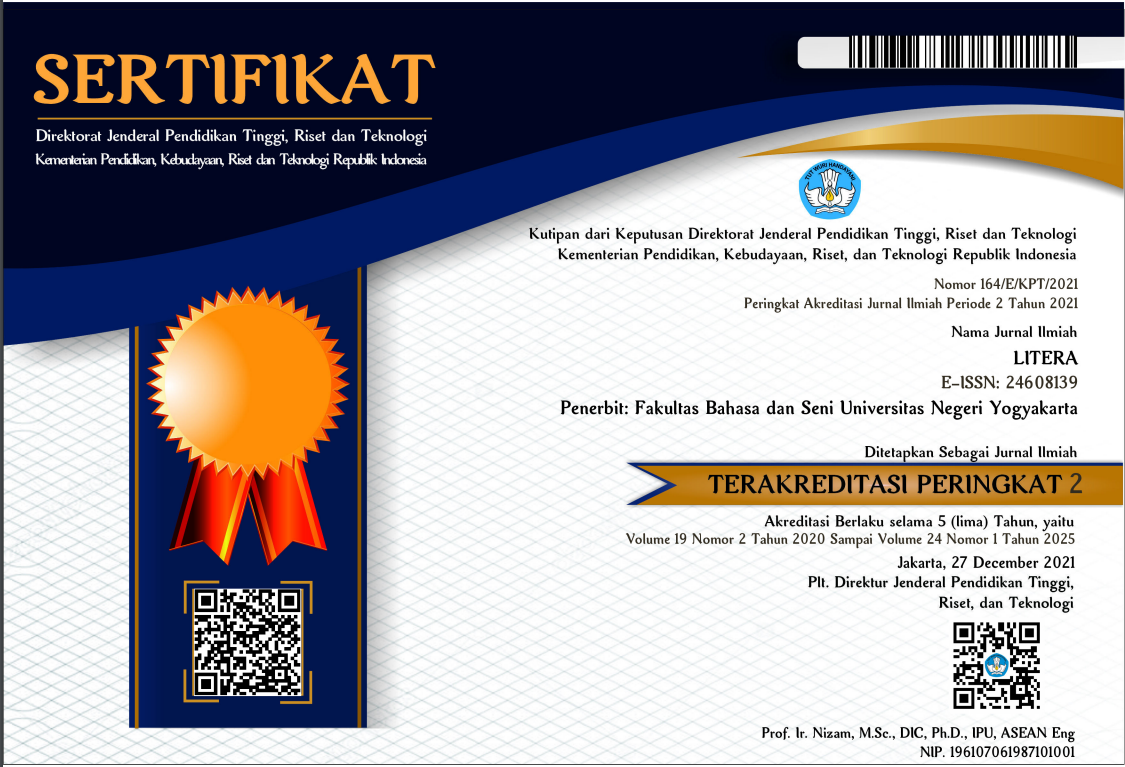WOMEN AND THE REPRODUCTION OF LITERARY NARRATIVES IN THE CONSTRUCTION OF NATION
Abstract
This study attempts to explore the positioning of women in literary narratives, particularly in the construction of the space known as “nation”. In discussions of nation and nationhood, these two concepts are frequently attributed to men. Questions of nationhood are also considered masculine, as nationhood is itself narrowly defined as nationalism or defense of the state. In such discussions, women are always excluded, as they are constructed quite differently from men. The narrative of nation is a complex one, in which men and women are differently constructed. Narratives of women are frequently and continuously reproduced, both by men and by women. If, in a social context, narratives of women are continuously reproduced, what are they like in literary narratives that construct the nation? What type of narration of women is constructed? Why is such a construction forefronted? This study specifically explains how women can be continuously present in literature.
Keywords: women, construction, narration, nation, literature
WANITA DAN REPRODUKSI NARASI SASTRA DALAM KONSTRUKSI BANGSA
Abstrak
Penelitian ini mencoba mengeksplorasi posisi perempuan dalam narasi sastra, terutama dalam konstruksi ruang yang dikenal sebagai “bangsa”. Dalam diskusi tentang bangsa dan kebangsaan, kedua konsep ini sering dikaitkan dengan laki-laki. Pertanyaan tentang kebangsaan juga dianggap maskulin, karena kebangsaan itu sendiri secara sempit didefinisikan sebagai nasionalisme atau pertahanan negara. Dalam diskusi semacam itu, perempuan selalu dikecualikan, karena dikonstruksi dengan cara yang berbeda dengan laki-laki. Narasi bangsa adalah hal yang kompleks; di dalamnya pria dan wanita dikonstruksi secara berbeda. Narasi perempuan sering dan terus diproduksi ulang, baik oleh pria maupun wanita. Jika dalam konteks sosial narasi perempuan terus-menerus direproduksi, bagaimana narasi perempuan dalam narasi sastra yang mengkonstruksi bangsa? Jenis narasi perempuan apa yang dikonstruksi? Mengapa konstruksi seperti itu dikedepankan? Penelitian ini secara khusus menjelaskan bagaimana wanita dapat terus hadir dalam sastra.
Kata kunci: wanita, konstruksi, bangsa, sastra
Full Text:
PDFReferences
Ajidarma, Sena Gumira. 1999. “Clara Atawa Wanita yang Diperkosa”. Downloaded from https://duniasukab. com/2007/04/14/clara-atawa-wanita- yang-diperkosa/
Anderson, Benedict. 2006. Imagined Communities: Reflection on the Origins and Spread of Nationalism (revised edition). London & New York: Verso.
Beauvoir, Simone de. 1957. Le Deuxieme Sexe. Paris: Gallimard.
Boucher, Geoff. 2006. “The Politics of Performativity: A Critique of Judith Butler”. In Parrhesia 1 pp. 112–141.
Butler, Judith. 1997. Excitable Speech: A Politics of Performative. London and New York: Routledge.
Cixous, Helene, Keith Cohen, and Paula Cohen. 1976. “The Laugh of the Medusa”. In Sign. 1(4), pp. 875–893.
Friedan, Betty. 1979. The Feminine Mystique.
New York: Dell Publishing.
McGregor, Judy. 2000. “Stereotype and Symbolic Annihilation: Press Construction of Women at the Top”. In Women in Management Review 15 (5/6), pp. 290–295.
Klein, Huge, & Shiffman S Kenneth. 2009. “Underrepresentation and Symbolic Annihilation in Socially Disenfranchised Groups (“ Out
Group”) in Animated Cartoons”. In The Howard Journal of Communications 1. pp. 55–72.
Lanser, Susan S. 2013. “Gender and Narrative”. In The Living Handbook of Narratology. Downloaded from http:// www.lhn.uni-hamburg.de/article/ gender-and-narrative on 8 May 2017.
Lauretis, Teresa de. 1987. Technologies of Gender: Essays on Theory, Film and Fiction Bloomington and Indianapolis: Indiana Univercity Press.
Mulvey, Laura. 1975. Visual Pleasure and the Narrative Cinema. (A reworked version of a paper given at the French Department of the University of Wisconsin, Madison)
Pratiwi, Margareth Widhy. 2001. Kinanti. Yogyakarta: Taman Budaya Propinsi Daerah Istimewa Yogyakarta.
Propp, Vladimir. 1968. Morphology of the Folktale (translation from Russian by Laurence Scott). Texas: University of Texas Press.
Smith, Katherine, M. 2008–2009. “Telling (T)he(i)r Story: The Rise of Female Narration and Women’s History in Isabel Allende’s The House of the Spirit” In Florida Atlantic Comparative Studies Journal 1. pp. 79–92.
Syafe’i, Abdul Malik. 2017. “Dekontruksi Pasal 25 Kompilasi Hukum Islam Tentang Kesaksian Perempuan dalam Perkawinan”. In Medina-Te, Jurnal Studi Islam 14(2), December.
Tuchman, Gaye. 1978.” Introduction: The Symbolic Annihilation of Women by the Mass Media”. In G. Tuchman, A.K. Daniels, and J. Benet (eds.). Hearth and Home: Image of Women in the Mass Media. pp. 3–38
Udasmoro, Wening. 2014. Konstruksi Identitas Gender dalam Sastra. Yogya- karta: Faculty of Cultural Sciences, Universitas Gadjah Mada.
Walby, Sylvia. 1980. Theorizing Patriarchy. Cambridge: Basil Blackwell.
Yuval-Davis, Nira. 2002. Gender and Nation. London: Sage Publication.DOI: https://doi.org/10.21831/ltr.v16i2.17411
Refbacks
- There are currently no refbacks.
______________________
__________________________________________________________________________________________________
Litera Journal is published by the Faculty of Languages, Arts, and Culture Universitas Negeri Yogyakarta in collaboration with Himpunan Sarjana Kesusasteraan Indonesia (HISKI)
The International Journal of Linguistic, Literature, and Its Teaching at http://http://journal.uny.ac.id/index.php/litera/ is licensed under a Creative Commons Attribution-ShareAlike 4.0 International License
__________________________________________________________________________________________________















